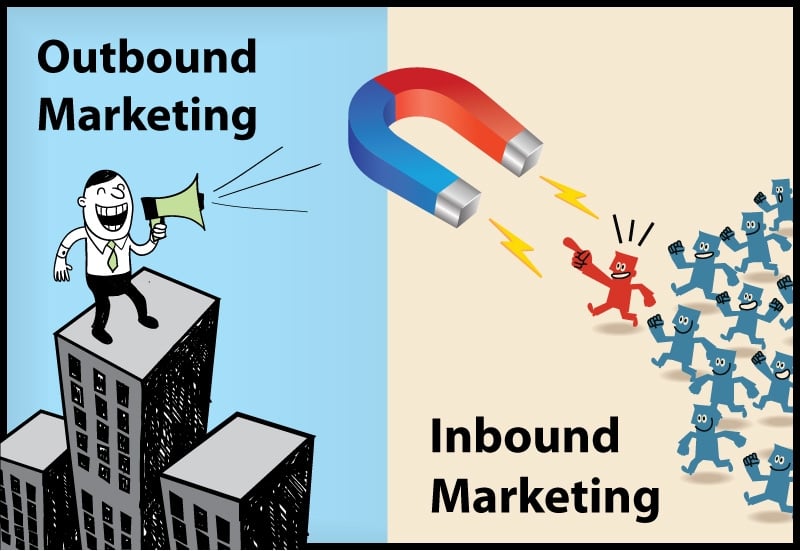Software Alone Isn't The Answer: Why Marketing Automation Fails
by Leanne Mordue on 09-Mar-2016 10:57:00

Many businesses sink a sizeable investment into marketing automation software in the hopes that it will make the sales and marketing processes easier and more streamlined, while at the same time organising contacts and segmenting lists, for a more tailored marketing approach. This does not always work out as envisioned, leading to a loss on the monetary investment made and time spent, both of which can never be fully recovered. But there are reasons, beyond the scope of the software, for the failure of this extremely powerful marketing tool. In this article, we will be looking at some of the main reasons why marketing automation software fails to deliver the desired results.
Getting Started
A common mistake, or rather misconception, about marketing automation software, is that it will completely take over your marketing functions. This could not be further from the truth. Marketing automation has been designed to enhance the scale of your already existing marketing efforts, with the aim of saving you time, money and other valuable resources. When it comes to the implementation of marketing automation software, it is imperative that you have a marketing automation strategy. Without a clear and concise strategy, your marketing efforts will be misguided and wasted, rendering the software completely under-utilised and possibly irrelevant.
Another thing to consider when thinking about the switch to automation is, do you have a strong enough lead base, a platform from which to launch your nurturing campaign down the funnel. Until marketers have a steady and strong enough organic lead flow through the marketing funnel, they do not have what is necessary to implement marketing automation for optimal success. When marketing automation is implemented correctly, it takes time and resources, combined with continuous efforts for its growth and maintenance, along with a strong lead base from which to prove itself a useful acquisition.
Marketing Channels
Traditional automated marketing made almost exclusive use of email marketing messages triggered by a certain time delay or actions, such as email opens and email clicks. Email marketing has lost its punch over the years since the advent of social media. This traditionally one-channel marketing option came with its limitations to your marketing efforts, in that it limited the number of viewers to your message, and left a bad taste in the mouths of those who often read rather generic content. The email also limits the scope and range of data that marketers need to better serve their prospects and customers want's and needs. Learn more about effective Email marketing - Is Email Marketing Effective? Why Your Prospects Don't Open Your Emails.
A well designed and strategically sound marketing automation system makes use of multiple channels through which to market your message. Incorporating the use of social media to reach a wider audience through inbound marketing strategies, while at the same time gathering valuable data around your particular target market within your designated demographic. The proper use of these channels is not the job of automation alone. Quality-rich and concise content is what does the work of getting those prospect’s attention, and keeping existing customers interested, thus getting the most out of your automation system while at the same time, gently guiding them through the nurturing phase, leading them where you want them to go.
Good and Bad Marketing Automation
Marketing automation that is implemented without the correct strategy, suited to your business’s unique goals and market offerings, is one that is doomed to fail. Taking the ever evolving needs and wants of your prospects and customers into account when developing an automation strategy is crucial, and can be done through the proper use of automation and implementation. Email is a way that automation gets passed to a particular customer or prospect, but without the proper employment of content with the automation, gathering the valuable data that you need is hampered through this single channel automation approach. While bad marketing automation approaches and strategies will leave you disappointed with your marketing ROI, utilising good marketing automation processes to their fullest potential will boost your bottom line while, at the same time, delighting your customers.
Marketers without good leads generation strategies tend to spend most of their time figuring out how best to squeeze what they can receive from their existing customer base while effectively ignoring the vastness that is their untapped market. Implementing an automation system on this premise is a bad marketing practice as selecting the wrong target market. Neither will provide you with the long-term sustainable returns you are searching for. How effective will your marketing automation be once you have squeezed the last penny out of your existing customers, without the means of generating new leads to create your continuous revenue stream?
In Conclusion
Marketing automation fails for numerous different reasons. Some are due to lack of planning and short-sightedness while another is the failure to produce content that is of the quality and informative nature that today’s educated consumers have become accustomed to. When deciding on whether or not your company is in a position to implement an automated marketing strategy, you should be able to provide assured answers to the following questions: Does your company have a clear and concise automation strategy? Does your firm have a solid platform for lead generation that will provide a consistent stream of leads through the nurturing process?
When choosing a marketing automation system, it's important to recognise that the software alone isn't enough - it needs to be implemented effectively. As the old saying goes, 'A fool with a tool is still a fool'.
That's why we recommend finding a good marketing partner to work with to ensure your investment in marketing automation has the full impact, and moves your business forward rather than being an expensive program that no-one actually uses!
- Inbound Marketing (SEO, PPC, Social Media, Video) (824)
- Strategy (363)
- Sales & CRM (195)
- Marketing Automation & Email Marketing (190)
- Business Growth (164)
- Website Design (160)
- Hubspot (138)
- Lead Generation (115)
- Google Adwords (98)
- Content Marketing (94)
- Conversion (48)
- Case Studies (47)
- News (47)
- Ecommerce (39)
- Webinars (34)
- SEO (24)
- AI (20)
- Events (19)
- Video (17)
- LinkedIn Advertising (15)
- Video Selling (15)
- Software training (13)
- Niche business marketing (11)
- The Digital Prosperity Podcast (10)
- Facebook Advertising (6)
- HubSpot Case Studies (5)
- December 2025 (10)
- November 2025 (6)
- October 2025 (17)
- September 2025 (16)
- August 2025 (14)
- July 2025 (14)
- June 2025 (5)
- May 2025 (19)
- April 2025 (15)
- March 2025 (13)
- February 2025 (13)
- January 2025 (8)
- December 2024 (2)
- November 2024 (4)
- October 2024 (21)
- September 2024 (4)
- August 2024 (8)
- July 2024 (14)
- June 2024 (16)
- May 2024 (25)
- April 2024 (15)
- March 2024 (18)
- February 2024 (5)
- January 2024 (10)
- December 2023 (6)
- November 2023 (10)
- October 2023 (13)
- September 2023 (12)
- August 2023 (14)
- July 2023 (13)
- June 2023 (14)
- May 2023 (15)
- April 2023 (13)
- March 2023 (14)
- February 2023 (13)
- January 2023 (15)
- December 2022 (13)
- November 2022 (6)
- October 2022 (8)
- September 2022 (22)
- August 2022 (15)
- July 2022 (13)
- June 2022 (16)
- May 2022 (14)
- April 2022 (16)
- March 2022 (17)
- February 2022 (11)
- January 2022 (8)
- December 2021 (6)
- November 2021 (7)
- October 2021 (11)
- September 2021 (10)
- August 2021 (7)
- July 2021 (7)
- June 2021 (4)
- May 2021 (4)
- April 2021 (1)
- March 2021 (3)
- February 2021 (5)
- January 2021 (4)
- December 2020 (7)
- November 2020 (6)
- October 2020 (5)
- September 2020 (9)
- August 2020 (18)
- July 2020 (17)
- June 2020 (17)
- May 2020 (10)
- April 2020 (21)
- March 2020 (24)
- February 2020 (21)
- January 2020 (12)
- December 2019 (23)
- November 2019 (12)
- October 2019 (14)
- September 2019 (16)
- August 2019 (15)
- July 2019 (13)
- June 2019 (6)
- May 2019 (8)
- April 2019 (4)
- March 2019 (2)
- February 2019 (2)
- January 2019 (2)
- December 2018 (3)
- November 2018 (24)
- September 2018 (11)
- August 2018 (9)
- June 2018 (3)
- May 2018 (6)
- April 2018 (14)
- March 2018 (12)
- February 2018 (16)
- January 2018 (15)
- December 2017 (15)
- November 2017 (18)
- October 2017 (23)
- September 2017 (19)
- August 2017 (28)
- July 2017 (27)
- June 2017 (25)
- May 2017 (18)
- April 2017 (17)
- March 2017 (16)
- February 2017 (17)
- January 2017 (14)
- December 2016 (21)
- November 2016 (27)
- October 2016 (25)
- September 2016 (16)
- August 2016 (20)
- July 2016 (19)
- June 2016 (14)
- May 2016 (20)
- April 2016 (24)
- March 2016 (22)
- February 2016 (28)
- January 2016 (27)
- December 2015 (28)
- November 2015 (19)
- October 2015 (9)
- September 2015 (12)
- August 2015 (5)
- July 2015 (1)
- June 2015 (10)
- May 2015 (3)
- April 2015 (11)
- March 2015 (14)
- February 2015 (15)
- January 2015 (12)
- December 2014 (2)
- November 2014 (23)
- October 2014 (2)
- September 2014 (2)
- August 2014 (2)
- July 2014 (2)
- June 2014 (7)
- May 2014 (14)
- April 2014 (14)
- March 2014 (7)
- February 2014 (2)
- January 2014 (7)
- December 2013 (9)
- November 2013 (14)
- October 2013 (17)
- September 2013 (3)
- August 2013 (6)
- July 2013 (8)
- June 2013 (4)
- May 2013 (3)
- April 2013 (6)
- March 2013 (6)
- February 2013 (7)
- January 2013 (5)
- December 2012 (3)
- November 2012 (2)
- September 2012 (1)
Subscribe by email
You May Also Like
These Related Blogs

Inbound Marketing Vs Outbound Marketing - Is Outbound Marketing Dead?
Marketing tactics to consumers and clients are changing rapidly. It’s not about asking, “Hey, do you want to buy this product or use these services?” …

Think Marketing Automation Is Just For Large Companies and Agencies? Think Again.
The goal of any type of automation is to increase throughput and efficiency in high volume processes. So, for instance, an automated manufacturing pro …

Create Business Marketing Fireworks By Following These 4 Simple Steps
Remember remember the 5th of November! Bonfire night is right around the corner so what better time to light up your marketing strategy and start crea …



